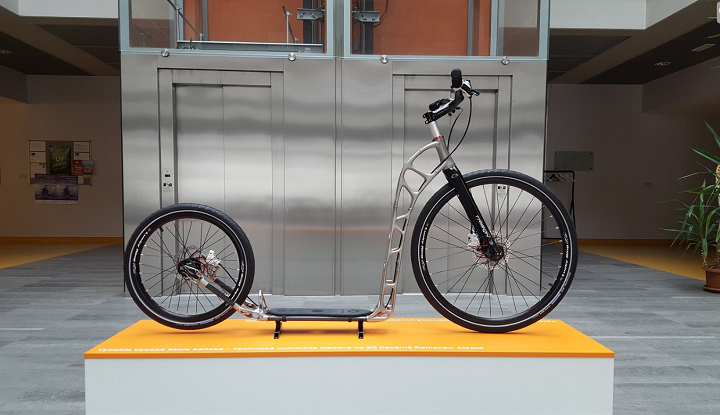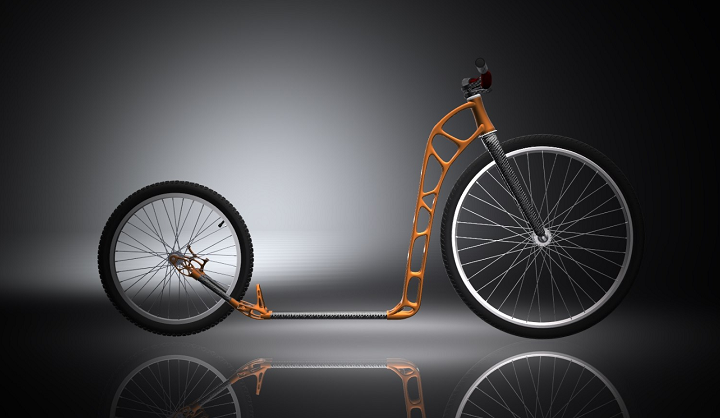Last summer, my husband and I took a vacation with his family to Tybee Island, which is about 18 miles east of Savannah, Georgia and a total of just 3.2 square miles. We all knew that parking would be an expensive nightmare in the main drag of the small town, and began discussing other options to get around, including renting golf carts and bikes. My husband was interested in purchasing a cheap scooter or pair of skates for the trip, though in the end we ended up mostly walking…however, his new skates remain, pristine and unused, in the back of our closet, but that’s a story for another day.
There are plenty of ways to get around town, from cars, buses, and bikes to scooters and skates, and 3D printing has been used to help create all of these modes of transportation. Now, a team from VŠB-Technical University of Ostrava in the Czech Republic has developed what they’re calling the first bionic scooter frame to be 3D printed from stainless steel.
Petr Štefek, a member of the university’s Protolab project, said in a translated quote, “We wanted to go by something that has not yet been realized.
“In addition, scooters are currently experiencing revival, many people are driving on them, which has also seemed attractive to us.”
Protolab provides companies with access to 3D printing services, so they have the chance to produce cost-effective functional models and prototypes.
“The whole process of 3D printing is process-intensive and costly, so we would like to offer these services to small and medium-sized companies and allow them to try modern methods of rapid prototyping and design,” Štefek said two years ago when Protolab began.
The team estimated that it cost several hundreds of thousands of Czech crowns to develop the 3D printed scooter frame prototype, though the project was partially financed by the Technology Agency of the Czech Republic within the PRE SEED VŠB-Technical University of Ostrava Fund project. But, the potential exists that the project could one day be commercialized, in order to create a serial model that customers can easily purchase.
Based on some of the scooter frame’s design specs, commercialization sounds like a great idea. The university’s Protolab team worked with Renishaw on the project, using its AM 400 system to 3D print the unique scooter frame out of stainless steel powder.
“Our prototype differs in weight, the 3.2 kilogram frame is about a quarter of a lighter weight than if it was made by the traditional method,” said Marek Pagáč, who directs the engineering team at the Protolab 3D print center. “Besides saving the material we achieved by making the parts lightweight and hollow, we put the greatest emphasis on the attractive design scooters and its distinctive sporty look.”
However, 3D printing wasn’t the only method of manufacturing used to create the functioning scooter frame…it’s actually divided into four consecutively welded parts.
“In addition to welding, we have glued carbon composite elements and machined functional surfaces,” explained the university’s Lukáš Jančar. “In addition, we needed to change them to get their smooth surface.”
The team is currently working on a second-generation version of their scooter, complete with a modified design. It should be ready by August, and plans are to introduce it at the International Engineering Fair in the Moravian city of Brno, which is the most important industrial fair in Central Europe.
Commercialization of the scooter really depends on how this next generation frame turns out, and a good outcome is reliant on the developers learning to continue working effectively with 3D printers. For example, if they can figure out a way to 3D print the scooter frame in just one piece, welding costs will be negated, which will then lower the overall price. In addition, engineers could also work on better calculating the frame’s strength and dimensions so that the scooter can be adjusted for each individual customer’s weight. This may bring the price up again, but as we’ve seen, many people are willing to pay a little extra for custom products.
All in all, however, at current DMLS (Laser Powder Bed Fusion, Direct Metal Laser Sintering, SLM) rates, this scooter would be cost-prohibitive, even with the welding optimization and customization. But, if the team could make it work, it would be a great step towards using 3D printing in frames.
What do you think? Discuss this work and other 3D printing topics at 3DPrintBoard.com or share your thoughts in the Facebook comments below.
[Source: bne IntelliNews]Subscribe to Our Email Newsletter
Stay up-to-date on all the latest news from the 3D printing industry and receive information and offers from third party vendors.
You May Also Like
3D Printing News Unpeeled: A $3000 SLS System, Construction Subsidies and Parameters
The Housing Affordability Crisis is one of Canadian President Trudeau’s biggest issues. Now the government has made subsidies available, including scaling new technologies, 3D printed housing and libraries of reapproved...
“Bundled Light” Enables High Quality Plastic 3D Printing from LEAM
Naturally, we expect current 3D printing methods to continuously improve, but it continues to do so in the most surprising ways. The latest development comes from LEAM, a startup spun...
Each to Their Own: Exploring Creality’s Latest Ender Trio as the Company Strengthens Its Commitment to 3D Printing Advocacy
Creality has reaffirmed its commitment to promoting 3D printing. The launch of the Ender-3 V3 SE, Ender-3 V3 KE, and Ender-3 V3 showcases the company’s dedication to catering to diverse...
3D Printing News Briefs, March 23, 2024: AM in the US Coast Guard, Navy, & More
In today’s 3D Printing News Briefs, we’re discussing the use of 3D printing in various branches of the military, including the U.S. Coast Guard, the U.S. Navy, and the German...



































